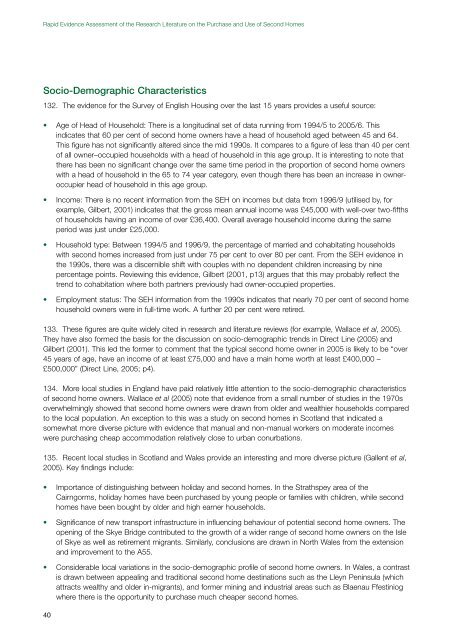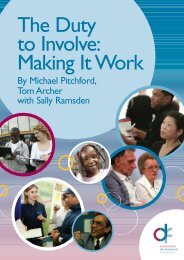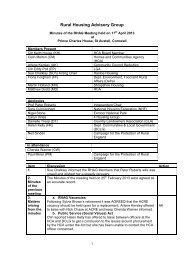Rapid Evidence Assessment of the Research ... - Rural Housing
Rapid Evidence Assessment of the Research ... - Rural Housing
Rapid Evidence Assessment of the Research ... - Rural Housing
Create successful ePaper yourself
Turn your PDF publications into a flip-book with our unique Google optimized e-Paper software.
<strong>Rapid</strong> <strong>Evidence</strong> <strong>Assessment</strong> <strong>of</strong> <strong>the</strong> <strong>Research</strong> Literature on <strong>the</strong> Purchase and Use <strong>of</strong> Second Homes<br />
Socio-Demographic Characteristics<br />
132.<br />
40<br />
The evidence for <strong>the</strong> Survey <strong>of</strong> English <strong>Housing</strong> over <strong>the</strong> last 15 years provides a useful source:<br />
• Age <strong>of</strong> Head <strong>of</strong> Household: There is a longitudinal set <strong>of</strong> data running from 1994/5 to 2005/6. This<br />
indicates that 60 per cent <strong>of</strong> second home owners have a head <strong>of</strong> household aged between 45 and 64.<br />
This figure has not significantly altered since <strong>the</strong> mid 1990s. It compares to a figure <strong>of</strong> less than 40 per cent<br />
<strong>of</strong> all owner–occupied households with a head <strong>of</strong> household in this age group. It is interesting to note that<br />
<strong>the</strong>re has been no significant change over <strong>the</strong> same time period in <strong>the</strong> proportion <strong>of</strong> second home owners<br />
with a head <strong>of</strong> household in <strong>the</strong> 65 to 74 year category, even though <strong>the</strong>re has been an increase in owneroccupier<br />
head <strong>of</strong> household in this age group.<br />
• Income: There is no recent information from <strong>the</strong> SEH on incomes but data from 1996/9 (utilised by, for<br />
example, Gilbert, 2001) indicates that <strong>the</strong> gross mean annual income was £45,000 with well-over two-fifths<br />
<strong>of</strong> households having an income <strong>of</strong> over £36,400. Overall average household income during <strong>the</strong> same<br />
period was just under £25,000.<br />
• Household type: Between 1994/5 and 1996/9, <strong>the</strong> percentage <strong>of</strong> married and cohabitating households<br />
with second homes increased from just under 75 per cent to over 80 per cent. From <strong>the</strong> SEH evidence in<br />
<strong>the</strong> 1990s, <strong>the</strong>re was a discernible shift with couples with no dependent children increasing by nine<br />
percentage points. Reviewing this evidence, Gilbert (2001, p13) argues that this may probably reflect <strong>the</strong><br />
trend to cohabitation where both partners previously had owner-occupied properties.<br />
• Employment status: The SEH information from <strong>the</strong> 1990s indicates that nearly 70 per cent <strong>of</strong> second home<br />
household owners were in full-time work. A fur<strong>the</strong>r 20 per cent were retired.<br />
133. These figures are quite widely cited in research and literature reviews (for example, Wallace et al, 2005).<br />
They have also formed <strong>the</strong> basis for <strong>the</strong> discussion on socio-demographic trends in Direct Line (2005) and<br />
Gilbert (2001). This led <strong>the</strong> former to comment that <strong>the</strong> typical second home owner in 2005 is likely to be “over<br />
45 years <strong>of</strong> age, have an income <strong>of</strong> at least £75,000 and have a main home worth at least £400,000 –<br />
£500,000” (Direct Line, 2005; p4).<br />
134. More local studies in England have paid relatively little attention to <strong>the</strong> socio-demographic characteristics<br />
<strong>of</strong> second home owners. Wallace et al (2005) note that evidence from a small number <strong>of</strong> studies in <strong>the</strong> 1970s<br />
overwhelmingly showed that second home owners were drawn from older and wealthier households compared<br />
to <strong>the</strong> local population. An exception to this was a study on second homes in Scotland that indicated a<br />
somewhat more diverse picture with evidence that manual and non-manual workers on moderate incomes<br />
were purchasing cheap accommodation relatively close to urban conurbations.<br />
135. Recent local studies in Scotland and Wales provide an interesting and more diverse picture (Gallent et al,<br />
2005). Key findings include:<br />
• Importance <strong>of</strong> distinguishing between holiday and second homes. In <strong>the</strong> Strathspey area <strong>of</strong> <strong>the</strong><br />
Cairngorms, holiday homes have been purchased by young people or families with children, while second<br />
homes have been bought by older and high earner households.<br />
• Significance <strong>of</strong> new transport infrastructure in influencing behaviour <strong>of</strong> potential second home owners. The<br />
opening <strong>of</strong> <strong>the</strong> Skye Bridge contributed to <strong>the</strong> growth <strong>of</strong> a wider range <strong>of</strong> second home owners on <strong>the</strong> Isle<br />
<strong>of</strong> Skye as well as retirement migrants. Similarly, conclusions are drawn in North Wales from <strong>the</strong> extension<br />
and improvement to <strong>the</strong> A55.<br />
• Considerable local variations in <strong>the</strong> socio-demographic pr<strong>of</strong>ile <strong>of</strong> second home owners. In Wales, a contrast<br />
is drawn between appealing and traditional second home destinations such as <strong>the</strong> Lleyn Peninsula (which<br />
attracts wealthy and older in-migrants), and former mining and industrial areas such as Blaenau Ffestiniog<br />
where <strong>the</strong>re is <strong>the</strong> opportunity to purchase much cheaper second homes.






